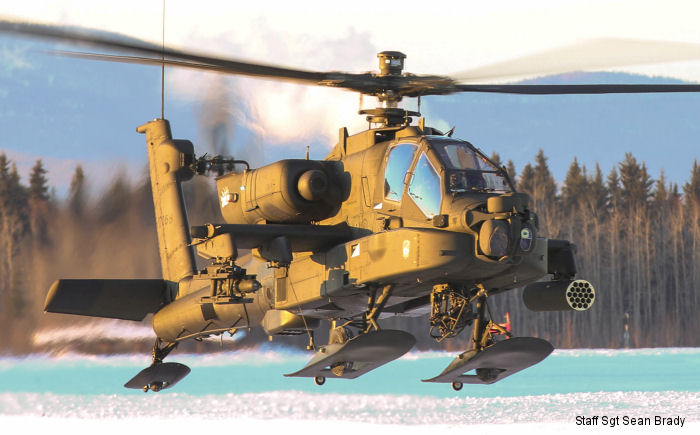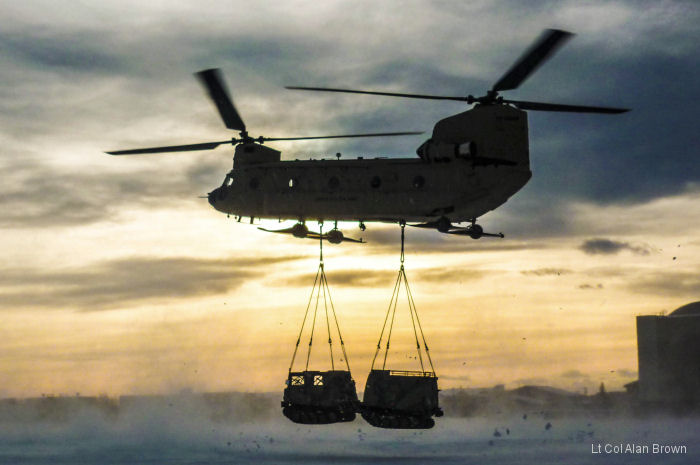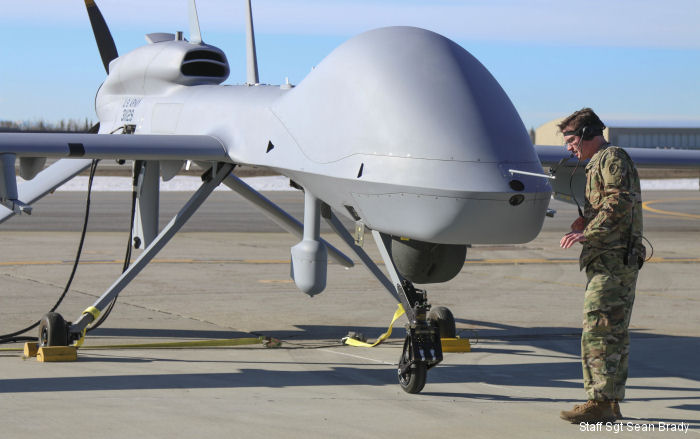US Army, April 18, 2016 - FORT WAINWRIGHT, ALASKA by Staff Sgt Sean Brady - It was a cool April morning and the Arctic Falcons of U.S. Army Alaska Aviation Task Force were hard at work, as CH-47 Chinooks, UH-60 Blackhawks and AH-64 Apaches checked systems in preparations for lift-off -- a typical day for Army aviation in Alaska.
The morning of April 11 was especially important for the Soldiers of UATF's Delta Company, 25th Aviation Regiment "Gray Eagle," as they prepared for the inaugural flight of the MQ-1C Gray Eagle Unmanned Aerial System in Alaska.
Just minutes after 10 a.m., the Gray Eagle left the tarmac, gaining altitude on its first flight in Alaskan airspace. Gray Eagle arrived in Alaska late last year to enhance the tactical capabilities of commanders in USARAK Aviation, Stryker and Airborne units, along with joint partners.
"It's taken more than four years and included countless Federal and DOD personnel to move Gray Eagle in Alaska forward," said Retired Chief Warrant Officer 4 Reed Greenwood, USARAK's lead aviation planner. "Making Gray Eagle a reality required USARAK to work closely with DOD-level aviation managers and to solicit recommendations and involvement from the Alaska public through a half-dozen outreach events."
The versatility of Gray Eagle gives units in Alaska the ability to train for wartime tasks with real-world combat assets. The aircraft is the newest addition to UATF's inventory, capable of operating in extreme cold regions across the globe.
"With the addition of the Gray Eagle, we continue to provide top notch, professional aviation support to the Stryker and Airborne Brigade while simultaneously maintaining MEDEVAC and aerial firefighting capabilities for the Army and our local partners," said Col. Blake Alexander, UATF commander.
UATF's diversity is shown not only by the aircraft they have, but through the variety of their missions and operating environments. Alaska has a range of weather and environmental conditions that cannot be replicated anywhere in the United States.
With extreme altitudes over the highest mountains in North America and in temperatures ranging from 90 degrees in the summer, to minus 50 degrees in the winter, UATF aviators are ready to fly, 24 hours a day, seven days a week, in support of emergency response medical evacuation missions for the Alaska Rescue Coordination Center and fight summer wild fires in support of the Bureau of Land Management. These missions go beyond the requirement to provide trained and ready aviation units to the U.S. Pacific Command and for other global contingency operations.
With the addition of an AH-64 Apache battalion in August 2015, UATF now has an aerial attack capability never seen before in Alaska. These arctic-capable Apaches are outfitted with skis year-round, stabilizing the aircraft when landing on muskeg, snowpack and glaciers. The 1st Attack Reconnaissance Battalion, 25th Combat Aviation Brigade, is currently testing an equipment pod to hold aviators' extreme cold-weather survival gear, a unique requirement for combat operations in extreme cold regions like the Arctic.
The current era of Army aviation in Alaska began in 2005 with Task Force 49, a medium combat aviation brigade headquarters. Over the next five years, TF 49 deployed seven modular aviation units to Iraq over five separate deployments. In 2011, TF 49 transitioned to become 16th Combat Aviation Brigade and the headquarters moved to Joint Base Lewis-McCord, Washington.
Now under the complete mission command of UATF and USARAK, Alaska aviation battalions have deployed modularly to Afghanistan and Korea and have supported five National Training Center rotations at Fort Irwin, California.
"I'm extremely proud of the accomplishments of the UATF headquarters and staff over the last 10 months", said Alexander. "This unit has demonstrated they can provide the leadership, coordination, mission command and oversight to achieve any mission for the Army and the state of Alaska."
With more aviation combat power now in the Pacific region than in recent memory, UATF stands ready to fly, fight and train in an area bigger than Texas, Montana, California and Kansas combined. Within that area is the Joint Pacific Alaska Range Complex, a series of training areas open to joint, interagency and multinational training. The JPARC consists of 65,000 square miles of airspace and 2,490 square miles of land space with 1.5 million acres of maneuver land. The space allows for full-spectrum engagements, combined arms exercises, and unique opportunities to train with international partners.
"We are looking forward to maintaining our engagement in the pacific with the Nepalese Army Aviation and future coalition partnerships," said Alexander. "I'm really looking forward to this summer as we expand our joint capabilities with the U.S. Air Force during the upcoming Red Flag and Arctic Anvil training exercises."
The morning of April 11 was especially important for the Soldiers of UATF's Delta Company, 25th Aviation Regiment "Gray Eagle," as they prepared for the inaugural flight of the MQ-1C Gray Eagle Unmanned Aerial System in Alaska.
Just minutes after 10 a.m., the Gray Eagle left the tarmac, gaining altitude on its first flight in Alaskan airspace. Gray Eagle arrived in Alaska late last year to enhance the tactical capabilities of commanders in USARAK Aviation, Stryker and Airborne units, along with joint partners.
"It's taken more than four years and included countless Federal and DOD personnel to move Gray Eagle in Alaska forward," said Retired Chief Warrant Officer 4 Reed Greenwood, USARAK's lead aviation planner. "Making Gray Eagle a reality required USARAK to work closely with DOD-level aviation managers and to solicit recommendations and involvement from the Alaska public through a half-dozen outreach events."
The versatility of Gray Eagle gives units in Alaska the ability to train for wartime tasks with real-world combat assets. The aircraft is the newest addition to UATF's inventory, capable of operating in extreme cold regions across the globe.
"With the addition of the Gray Eagle, we continue to provide top notch, professional aviation support to the Stryker and Airborne Brigade while simultaneously maintaining MEDEVAC and aerial firefighting capabilities for the Army and our local partners," said Col. Blake Alexander, UATF commander.
UATF's diversity is shown not only by the aircraft they have, but through the variety of their missions and operating environments. Alaska has a range of weather and environmental conditions that cannot be replicated anywhere in the United States.
With extreme altitudes over the highest mountains in North America and in temperatures ranging from 90 degrees in the summer, to minus 50 degrees in the winter, UATF aviators are ready to fly, 24 hours a day, seven days a week, in support of emergency response medical evacuation missions for the Alaska Rescue Coordination Center and fight summer wild fires in support of the Bureau of Land Management. These missions go beyond the requirement to provide trained and ready aviation units to the U.S. Pacific Command and for other global contingency operations.
With the addition of an AH-64 Apache battalion in August 2015, UATF now has an aerial attack capability never seen before in Alaska. These arctic-capable Apaches are outfitted with skis year-round, stabilizing the aircraft when landing on muskeg, snowpack and glaciers. The 1st Attack Reconnaissance Battalion, 25th Combat Aviation Brigade, is currently testing an equipment pod to hold aviators' extreme cold-weather survival gear, a unique requirement for combat operations in extreme cold regions like the Arctic.
The current era of Army aviation in Alaska began in 2005 with Task Force 49, a medium combat aviation brigade headquarters. Over the next five years, TF 49 deployed seven modular aviation units to Iraq over five separate deployments. In 2011, TF 49 transitioned to become 16th Combat Aviation Brigade and the headquarters moved to Joint Base Lewis-McCord, Washington.
Now under the complete mission command of UATF and USARAK, Alaska aviation battalions have deployed modularly to Afghanistan and Korea and have supported five National Training Center rotations at Fort Irwin, California.
"I'm extremely proud of the accomplishments of the UATF headquarters and staff over the last 10 months", said Alexander. "This unit has demonstrated they can provide the leadership, coordination, mission command and oversight to achieve any mission for the Army and the state of Alaska."
With more aviation combat power now in the Pacific region than in recent memory, UATF stands ready to fly, fight and train in an area bigger than Texas, Montana, California and Kansas combined. Within that area is the Joint Pacific Alaska Range Complex, a series of training areas open to joint, interagency and multinational training. The JPARC consists of 65,000 square miles of airspace and 2,490 square miles of land space with 1.5 million acres of maneuver land. The space allows for full-spectrum engagements, combined arms exercises, and unique opportunities to train with international partners.
"We are looking forward to maintaining our engagement in the pacific with the Nepalese Army Aviation and future coalition partnerships," said Alexander. "I'm really looking forward to this summer as we expand our joint capabilities with the U.S. Air Force during the upcoming Red Flag and Arctic Anvil training exercises."
See also |
1-52d AVN
1-25 AVN







